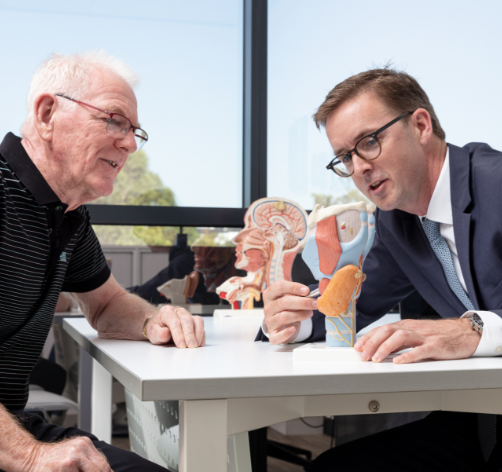The Thyroid and Parathyroid Glands
What does the Thyroid and Parathyroids do?
The Thyroid Gland
The thyroid gland is a butterfly shaped organ that sits at the base of the neck in front of the windpipe. Except in very thin people you cannot usually see the thyroid gland. It is comprised of two lobes joined by the isthmus in the middle. The gland is attached to the windpipe and moves up and down with swallowing.
Thyroid Hormones
The thyroid gland makes thyroid hormones. There are two main hormones called T3 (tri-iodothyronine) and T4 (thyroxine). The thyroid gland first takes up dietary iodine from the blood stream and uses it as a building block to make thyroid hormones. Thyroid hormone production is under the control of another important hormone produced in part of the brain called the pituitary gland, this is called thyroid stimulating hormone (TSH). TSH stimulates the thyroid to make more hormones and to secrete them into the circulation. Thyroid hormones travel through the blood to act on many tissues in the body especially those involved in growth and metabolism. Measurement of these hormones in the blood stream can help to diagnose problems with the thyroid gland (Thyroid Function Tests).

Overactivity and Underactivity of the Thyroid Gland
These conditions are common and are usually looked after by your family doctor sometimes in consultation with an Endocrinologist. Only rarely would you need to see a surgeon if you have an underactive or overactive thyroid gland. Surgery can sometimes be useful if you have an overactive thyroid gland and medicines are unsuitable for you or do not fully control the problem. (See Surgery for Hyperthyroidism)

The Parathyroid Gland
The 4 parathyroid glands are located on the back of the thyroid gland. They are tiny, each one normally measuring around 5mm in size. Despite their small size they perform a vital role. They control the amount of calcium in the bloodstream. Our bodies need a stable calcium level so that nerves and muscles can work normally. Too little calcium in the bloodstream can cause muscles to go into spasm and nerves to stop working, a condition called Tetany.
The parathyroids make parathyroid hormone (PTH). PTH travels around the body in the blood and works to increase the amount of calcium. It does this by acting mainly in 3 ways 1) by dissolving calcium from the bones, 2) by reabsorbing calcium in the kidneys from the urine and 3) by acting with Vitamin D to increase the amount of dietary calcium we take up from our gut.
Another important factor in Calcium maintenance is Vitamin D. This is absorbed from our diet and converted to its active form by the action of UV light on our skin. It then is activated by PTH and helps to increase calcium absorption from the gut.
There are 3 main parathyroid problems that we see in our practice:
Thyroid and Parathyroid Conditions and Treatments
Hyperthyroidism
Hypothyroidism
Parathyroid Problems
Parathyroid Surgery
Radioactive Iodine (RAI) Treatment
Iodine is one of the key building blocks that the thyroid gland uses to make the thyroid hormones tri-iodothyronine (T3) and thyroxine (T4).
Thyroid cancer
Lumps and nodules in the thyroid gland are extremely common. Most of these nodules are benign.
